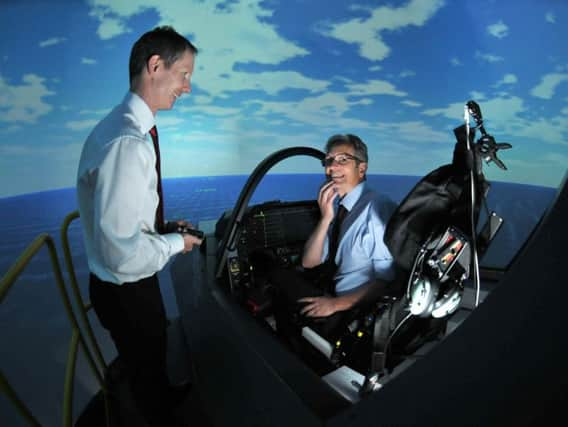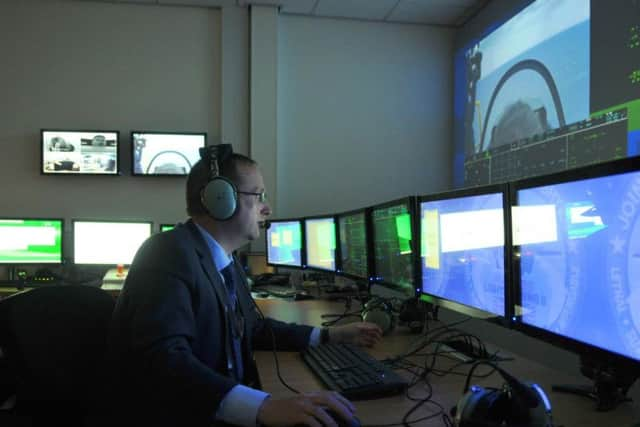Inside the Fylde coast's £2m F35 flight simulator


Having said that, there was no real concern – I was using the 3D computerised simulator that BAE Systems has created at Warton to help train navy pilots to use the new F-35B Lightning 2 set to be delivered next year.
In fact, the only real danger, was of me embarrassing myself by bungling the flight and crash landing, despite being told by everyone who had a go before me that it was easy. In truth, the cutting-edge technology does make it easy for experienced pilots, with the option to use the on-board computers to slow the F-35 to the same speed as the aircraft carrier at sea and then land gently using the its vertical landing abilities.
Advertisement
Hide AdAdvertisement
Hide AdThe £2m simulator allows pilots to practice before they get their hands on the real thing, and to test how the aircraft will perform under extreme conditions.


It is housed in a room with a 360 degree screen surrounding the cockpit, which itself is held on a hydraulic frame which mimics the real movement of the jet.Sitting in the cockpit you are totally immersed in the simulated world.
You feel the movement of the aircraft through the seat of your pants as you shift the joystick in your right hand and push forward on the throttle in your left. In front of you are an array of frankly bewildering displays and dials, while right before your eyes is a display showing all the crucial information a pilot needs such as direction and airspeed.
Starting in the air, I had to speed up and position the F-35 just left of the carrier.
Advertisement
Hide AdAdvertisement
Hide AdBAE Systems’ David Bennett gave the word, “Okay, you can go faster, faster, no a little faster please.”


Nerves had taken control and my movements on the controls were too tentative.
“To the left of the ship,” a tired pause, “No, the other left.”
Things had not started well. It reminded me of the start of my driving test.
“Okay that’s better.”
I arrived at the side of the ship in the blink of an eye.
Advertisement
Hide AdAdvertisement
Hide Ad“Okay stop please, just press that button on the underside of the throttle and let go.”
Somehow the computer took control and I found myself hovering off the port side of the ship looking across at the huge aft tower which controls the air operation on the carrier.Next, a movement right with the joystick took me over the right landing spot on the deck and pushing forward I lowered the aircraft.
At a prompt from my controller I pressed another button and the computer took over and lowered the aircraft gently to the deck.
Easy it was. What I had forgotten was that the engines of the jet were still running and the aircraft was drifting towards the control tower. “Brakes. Brakes. Press forward on the rudder controls to hold it.”
The look on the controller’s face was priceless.
Advertisement
Hide AdAdvertisement
Hide AdThe rudder controls just moved it even more, until I realised that by pressing with your toes, the brakes come on.
“Okay, take off. You see that ramp ahead.”
Off to the left at the front of the deck is a ski-jump to get the F-35s in the air.
I eased the throttle forward but not far enough.
“Push hard, take it right forward to the end.”
It took a real push forward with the left hand and I could feel the power come on. Toes off the brake and steer for the ramp.
It was a lot like a computer game. I hit the ramp fairly square on and the jet hit the air. With a cheeky wiggle of the wings and a turn to the right the F-35 was airborne.Fairly easy, but I don’t think the Navy is going to come calling for my services any time soon.
Advertisement
Hide AdAdvertisement
Hide AdThe F-35 project between the US and international partners such as BAE Systems is the most expensive defence project in the world, so just how much better is a fifth generation warplane compared to the existing fourth generation aircraft such as the Typhoon or Rafale?
Steven Over, Lockheed Martin’s director of F-35 international business development, explained.
He said: “The Typhoon is a wonderful aircraft and many people would ask why do we need the next generation. Well it is all to do with being able to deal with the power of large nations’ actors.”
He said the F-35’s stealth ability, its high performance, its improved computer avionics and its integration of its sensor abilities made it bound to beat any fourth generation aircraft it comes up against. In stealth mode, with all its weaponry concealed within the bodywork of the aircraft, it would be almost impossible for an anti-aircraft missile to target.”
Advertisement
Hide AdAdvertisement
Hide AdBut he said it was its sensor suite which made it, and any fourth generation aircraft alongside it, much better.
He said: “The F-35 computers talk to each other and share information. From 30 or 40 thousand feet a pilot can see every radar transmitter right up to the horizon. It gives them a total view of the battle space and this can be shared to fourth generation legacy aircraft.
“In current aircraft, the pilot spends most of his time using sensors to create a mental picture of threats and targets. The F-35 does all that for them and puts it up in a 3D airspace in front of them.
“It frees the pilot to become strategic battle managers. They are virtually omniscient.”